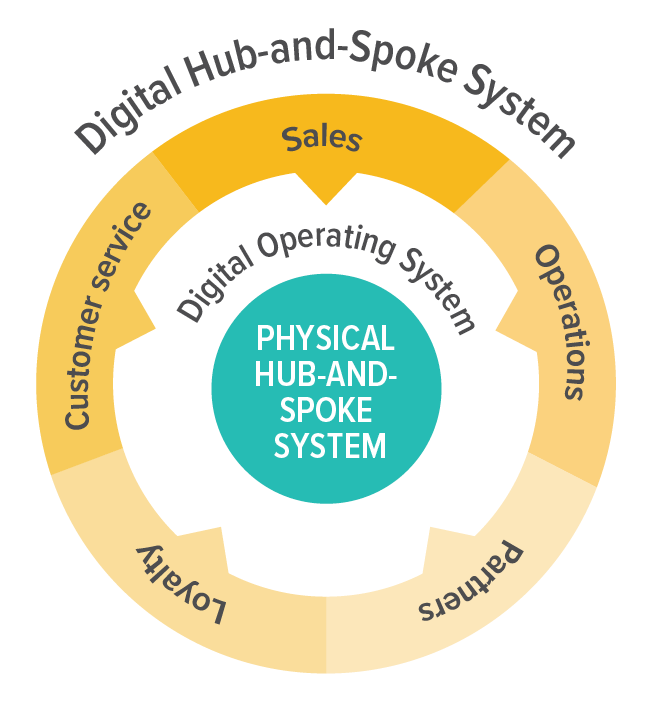Digital Transformation of the Airline Business
Digitising the Airline Business: why and how, presented in the last issue of Airline Leader, raised some questions about the "how" part of my commentary.
Airline leaders clearly understand the continual need to identify new frontiers in aligned value - ways to enhance customer experience and profit margins simultaneously. While airline leaders who have taken a deeper dive into the value of digital transformation of the airline business - implementing new ways to compete to produce value for customers as well as airlines - do appreciate its value, they also identify the enormity of the challenge of digital transformation - from its conceptual design, to the details of its implementation, followed by its flawless execution. Based on my recent experience from working with a group of airline executives in business and strategy development and technology enablement departments, let me start at the conceptual design level - the value of a digital operating system that will help an airline get the most out of its physical and human assets.
Airlines have clearly mastered the deployment of physical hub-and-spoke systems that (1) produce enormous productivity gains in an airline's use of its physical assets (aircraft, crew, gates, slots, maintenance staff, facilities, and so forth) and (2) extend, at the same time, the depth and breadth of an airline's network and schedules to produce substantial value for the airline's customers. However, despite the power and enormous value of physical hub-and-spoke systems to both airlines and customers, there are limitations relating to their customer centricity, scalability, agility, and optimisation at the enterprise level.
On top of that, these systems come with a zero sum game feature, meaning that the assets coming in are equal to the assets going out. The figure below shows a simple view of the concept. If X number of airplanes come into a hub, then X number leave the hub. The optimisation process relates to the use of techniques, processes, and systems to optimise the use of physical assets. These could be aircraft, crew, airports gates/slots, subsidiaries, alliance partners (and now JVs) to maximise the transportation of traffic by volume and/or dollar value or minimise costs, or a combination of both to maximise profit based on the input from related systems, such as revenue management.
Moreover, the optimisation process works within longer-term frameworks. Fleet planning relates to years and schedule planning is normally conducted on an annual basis with small changes made throughout the year to account for variations in demand based on season, day of the week, and so forth. The development of the schedule, of course, pays attention to many operational considerations (such as crew, maintenance, and airport facilities) and commercial considerations (such as revenue from passengers and shippers). The whole process is complex and difficult to adapt in real time to the dramatically changing demand of the marketplace from the viewpoint of customers and airlines. Customers want, for example, products that not only meet their end-to-end needs but also experience. Airlines want to be able to plan in as close to real time as possible.
The answer is to work with a digital operating system that wraps around the physical hub-and-spoke system to facilitate the development of customer-facing innovations and smart airline planning processes and systems, such as digital hub-and-spoke systems. One highly seasoned airline executive with a thorough appreciation of digital technologies helped to develop the following analogy. A rotary phone worked well with an analogue operating system that worked with a basic phone number, copper wires, and integration of various cables. Then, when the digital phone came, it was not a digitised version of a rotary phone. It was based on a digital operating system that led to numerous customer-facing innovations such as speed dialling, caller ID, three-way calling, music playing while on hold, and VoIP. Some of these functions could conceivably have been added to the rotary phone

using the analogue operating system, such as speed dialling and redialling, but they would have involved an incredible amount of complexity and expense, not to mention ongoing support. Other functions and features would have been almost impossible to develop, let alone make some features integrated. The digital operating system introduced many more customer-friendly functions by enabling the management of information.
So, if an airline is to introduce customer-facing innovations relating to its products and services and, at the same time, make the existing planning systems smarter by providing agility and scalability, new operating systems are needed. These systems need to be digital in which the inputs and outputs are still assets but they now relate to information coming from different functions and groups such as sales, operations, customer service, and loyalty (a digital hub-and-spoke system). Moreover, they must encompass software that integrates data coming from different sources, uses analytics to process the data, and integrates functions to produce and deliver aligned values. And, let us not overlook the value of the digital operating system as a platform for app developers to enable an airline to become a provider of mobility as a service rather than seats from one airport to another.

Airlines, of course, have vast quantities of information. However, as I have written many times before and have observed within airlines where I have worked, the information tends to be transactional, unstructured, and unconnected, warehoused in different organisational silos within the airline. And, although many airlines also possess some analytics (in some cases, quite sophisticated) their use is neither comprehensive within individual operational and commercial functions nor spread throughout the organisation. As such, what I am suggesting is a different conceptual system that is much more organised. The information gathered is much more comprehensive, it is connected, and its use is optimised with the deployment of an equally comprehensive set of analytics that analyse the information, massage it, and make it available for determining what happened, why it happened, what could happen, and what should happen.
The old hub-and-spoke system represents an integration point where growth opportunities are created. This system is still needed as it is still integral to the airline business. However, the physical hub-and-spoke systems are not unique (relative to competition), not able to give an airline a tightly integrated marketing capability to produce aligned value, and not able to handle an incredibly large number of options in a very short period of time and offer integrated solutions in almost real time.
A digital operating system, along with a digital hub-and-spoke system, will support a tightly integrated marketing capability that will enable an airline to sense quickly and effectively customer needs and create and deliver value propositions at an accelerated pace. Think about Uber's digital operating system that enables the availability of "surge pricing" that allows customer volumes, driver availability, and taxi service levels to be managed simultaneously and in real time. Digital operating systems can offer unforeseen product features. Think about the time when e-ticketing was explored by airlines. Did the marketing groups envision the ability to offer last minute specials enabled by e-ticketing?
The integrated nature of marketing (enabled by a digital operating system) will ensure the existence of the, often missing, intra-functional and cross-functional integration, and deliver products and experiences based on 360 degree views of individual customers, not to mention partners and competitors. Equally important is the point that the integrated and dynamic nature of airline marketing, coupled with the fundamental transformation of the existing reservation and revenue management systems, could reduce airline schedule planning time from 12 months to more like a couple of months, and possibly even enable an airline to run without budgets, similar to Aldi.